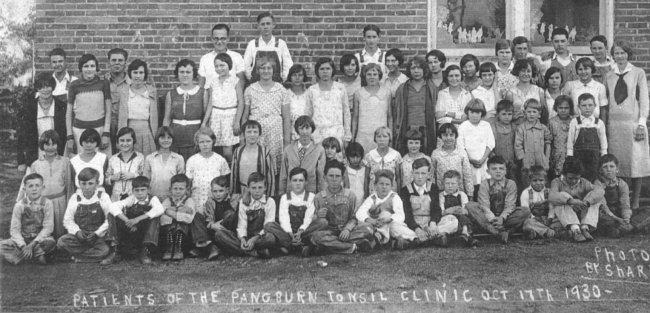
--photo courtesy Christina Doyle Spear (2d from left, next to last row),
White County Historical Society
Say ‘ahhh’ …
Patients tell of unique clinic at Pangburn School in 1930
By HEBER TAYLOR
Arkansas Democrat-Gazette, December 10, 2000
The Guinness Book record keepers might be interested to know that 60 Pangburn students underwent tonsillectomies at school in one session on October 17, 1930. The students, now senior citizens, remember the occasion well.
Pauline Edwards of Pangburn, then a sophomore, said recently that although she and almost everyone else came out of the experience in good shape, it wasn’t an easy day. "It seemed like half of Pangburn was there," she said. "Several [patients] swallowed their tongues. It was a mess with all those people hollering, screaming and taking on."
Pauline had two younger sisters and a brother who were supposed to have their tonsils removed that fall day. The girls dutifully submitted to surgery, but her brother bolted and evaded it, she said.
Christina Spear, now of Little Rock, has written about her experience in the mass tonsillectomy: "When I was in the 10th grade, the county health doctor came to school and examined all children who had a history of sore throat. He made plans to set up a clinic at school to remove all diseased tonsils.
"The school became a hospital for a couple of days. Classrooms became operating rooms; Army cots were brought in; and the auditorium became the recovery room where [some] patients stayed overnight. Parents cared for their own children following surgery."
R.C. McCourt was a fifth-grader when his tonsils were amputated. His summary of the 60 tonsillectomies is this: "It was a bloody time that October day."
He said that surgeries were performed in the superintendent or principal’s office on two tables set side by side. He thinks seven doctors rendered their services without charge. They were Drs. McAdams and Peeler from Pangburn; Dr. Spain from Letona; Drs. Harrison, Rodgers and Tapscott from Searcy; and Dr. Cosgrove from Little Rock.
A picture made on Tonsil Clinic Day shows seven nurses who assisted the doctors.
McCourt remembers that getting free tonsillectomies for their children was important to families in 1930. "The Depression had started in 1929, and a drought in July and August of 1930 had cut the cotton crop back to something like a third," he said.
Local people furnished pots, pans and sheets for the tonsil clinic. Sheets were put up in the auditorium so that boys and girls would have their own recovery areas.
The anesthesia used for the surgeries was ether. It was administered by a sponge that covered the nose, Christina Spear said.
"I fought the anesthetic, so it took more ether to put me under, and I almost didn’t wake up," Spear said. "No one knew at the time that I had a heart murmur."
Dale Van Patten of Searcy was in the second grade at the time. He also remembers having trouble with the ether. He said he got an overdose and became so relaxed that he swallowed his tongue. His mother, who was nearby, called a nurse to retrieve it.
Van Patten was one of the patients who had to spend the night in the recovery area. The next day, his father carried him home in his arms, about a quarter of a mile away. The youngster had to miss two or three days of school, mainly because of the ether, he said.
R.C. McCourt struggled so much with the ether that his father thought he was suffocating. "He almost stopped the operation," McCourt said. "I felt like I was going round and round, like a merry-go-round."
The ether seemed to get to everyone. "It knocked me crazy," Pauline Edwards said. "I just talked every way."
Her sisters got to go home, but Edwards had to stay in the recovery area overnight. She thinks that at least half the patients were obliged to spend the night there.
McCourt remembers an incident from the night. Dr. Spain, who weighed about 220 pounds, tried to get some sleep during the night on an operating table. "He fell off when he tried to turn over and hit the floor with a crash," McCourt said.
By today’s standards, the Pangburn tonsil clinic of 1930 had some weaknesses. Spear thinks that the surgical conditions were primitive and unsanitary.
"Many guardian angels were busy that day … You just know they didn’t have 60 sets of sterile instruments or any way to sterilize them," she wrote. "There was no plumbing or running water. Tonsils were carried out by the bucketful and dumped in the woods back of the schoolhouse. I can imagine the animals of the night had a feast…"
Van Patten, who later served as a medic in World War II, agreed that the tonsil clinic was basic. But he also said that it was state of the art for the times, and the doctors were doing their best.
Most students progressed nicely after the tonsillectomies. Pauline Edwards could think of only one student who didn’t do well after surgery.
"I got along fine," Edwards said. " I was always having tonsillitis and having to miss school [before the operation]. After the operation, I didn’t have that problem."
(The author is a member of the White County Historical Society.)